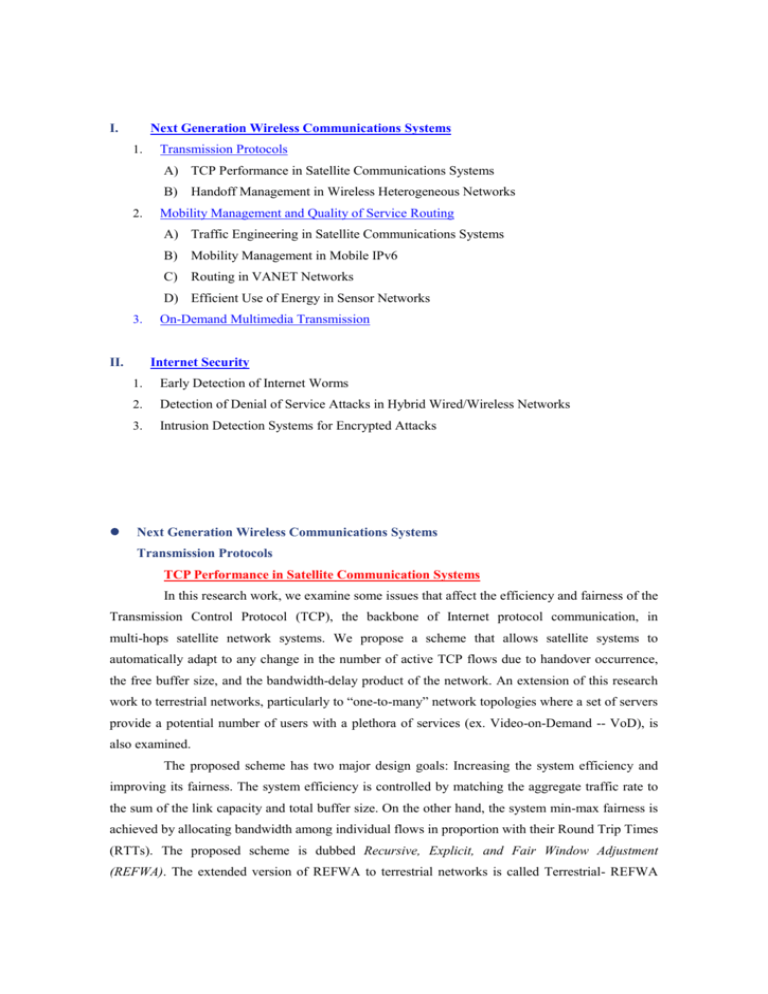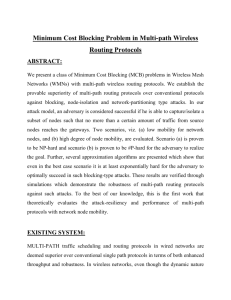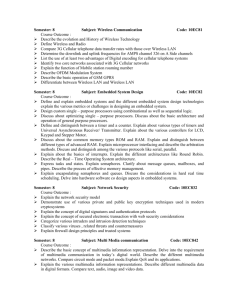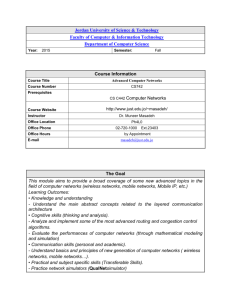Next Generation Wireless Communications Systems
advertisement

I. Next Generation Wireless Communications Systems 1. Transmission Protocols A) TCP Performance in Satellite Communications Systems B) Handoff Management in Wireless Heterogeneous Networks 2. Mobility Management and Quality of Service Routing A) Traffic Engineering in Satellite Communications Systems B) Mobility Management in Mobile IPv6 C) Routing in VANET Networks D) Efficient Use of Energy in Sensor Networks 3. II. On-Demand Multimedia Transmission Internet Security 1. Early Detection of Internet Worms 2. Detection of Denial of Service Attacks in Hybrid Wired/Wireless Networks 3. Intrusion Detection Systems for Encrypted Attacks Next Generation Wireless Communications Systems Transmission Protocols TCP Performance in Satellite Communication Systems In this research work, we examine some issues that affect the efficiency and fairness of the Transmission Control Protocol (TCP), the backbone of Internet protocol communication, in multi-hops satellite network systems. We propose a scheme that allows satellite systems to automatically adapt to any change in the number of active TCP flows due to handover occurrence, the free buffer size, and the bandwidth-delay product of the network. An extension of this research work to terrestrial networks, particularly to “one-to-many” network topologies where a set of servers provide a potential number of users with a plethora of services (ex. Video-on-Demand -- VoD), is also examined. The proposed scheme has two major design goals: Increasing the system efficiency and improving its fairness. The system efficiency is controlled by matching the aggregate traffic rate to the sum of the link capacity and total buffer size. On the other hand, the system min-max fairness is achieved by allocating bandwidth among individual flows in proportion with their Round Trip Times (RTTs). The proposed scheme is dubbed Recursive, Explicit, and Fair Window Adjustment (REFWA). The extended version of REFWA to terrestrial networks is called Terrestrial- REFWA (T-REFWA). Simulation results elucidate that the REFWA and T-REFWA schemes substantially improve the system fairness, reduce the number of packet drops, and make better utilization of the bottleneck link. The results demonstrate also that the proposed schemes work properly in more complicated environments where connections traverse multiple bottlenecks and the available bandwidth may change over data transmission time. Handoff Mangament in Wireless Heterogeneous Networks Recent trends in telecommunication industry are toward the development of ubiquitous information systems where the provision of a plethora of advanced multimedia services should be possible regardless of time and space limitations. An efficient and seamless delivery of multimedia services over various types of wireless networks is still a challenging task. The underlying difficulty consists in the disparity in the bandwidth availability over each network type. Indeed, the fundamental challenge upon a handoff phenomenon in a heterogeneous wireless network consists in an efficient probing of the bandwidth availability of the new network, followed by a prompt adjustment of the data delivery rate. In this research work, we design and evaluate a cross layer approach that involves five layers, namely physical, data link, application, network, and transport layers. The three former layers are used to anticipate the handoff occurrence and to locate the new point of attachment to the network. Based on their feedback, the transport layer is used then to probe the resources of the new network using low-priority dummy packets. This bandwidth probing operation is called Dummy Segment based Bandwidth Probing (DSBP). Being the most widely used protocols for multimedia delivery, this research work addresses multimedia applications based on TCP and RTP protocols. The design of the whole cross layer architecture is discussed and enhancements to the two protocols are proposed. The performance of the enhanced TCP and RTP protocols is evaluated and compared with existing schemes through extensive simulations. The obtained results are encouraging and promising for the delivery of multimedia services in heterogeneous wireless networks. Mobility Management and Quality of Service Routing Traffic Engineering in Satellite Communications Systems Due to geographical and/or climatic constraints, the community of future satellite users will exhibit a significant variance in its density over the Globe. This density variance will yield a scenario where some satellite links are congested while others are underutilized. To ensure an intelligent engineering of traffic over satellite networks, this research work envisions a routing protocol that enables neighboring satellites to explicitly exchange information on their congestion status. A satellite that is about to get congested requests its neighboring satellites to decrease their data forwarding rates. In response, the neighboring satellites search for less congested paths that do not include the satellite in question and communicate a portion of data, primarily destined to the satellite, via the retrieved paths. By so doing, congestion, and the resulting packet drops, can be avoided. A better distribution of traffic among satellites can be guaranteed as well. The proposed scheme is dubbed “Explicit Load Balancing” (ELB) scheme. A set of simulations is conducted to evaluate the performance of the ELB scheme using the Network Simulator. In terms of Quality of Service, encouraging results are obtained: better traffic distribution, higher throughput, and lower packet drops. While this research work considers the case of satellite communications systems, the proposed mechanism can be easily applied also to terrestrial networks where nodes are aware of their neighboring nodes. Mobility Management in Mobile IPv6 Recent trends in telecommunications industry are toward ubiquitous information technologies. Communications over emerging mobile networks are thus gaining a tremendous interest at both industrial and academic levels. A major concern for mobile networks consists in finding efficient ways to handle the user mobility so that the handover process has minimum effect on user's ongoing sessions. Given the dominance of Internet-based applications in next-generation mobile networks, Mobile IP has become an important protocol to accommodate the IP mobility. To overcome the excessive delay and signaling involved in the first version of Mobile IP, the Hierarchical Mobile IPv6 (HMIPv6) protocol has been introduced. The key concept behind HMIPv6 is to locally handle handovers by the usage of an entity called Mobility Anchor Point (MAP). While the new protocol provides a more efficient way for the mobility management in IP networks, it does not control traffic among multiple MAPs in the network. As a result, in many cases the selected MAP is overloaded and extensive delays are experienced during the routing process. To tackle this problem, this research work portrays a new technique called Dynamic and Efficient MAP Selection (DEMAPS). In the proposed scheme, the most optimum MAP with the lightest traffic load is selected. This selection is based on an estimation of MAP load transition using the Exponential Moving Average (EMA) method. Simulation results demonstrate that DEMAPS can balance the signaling traffic load efficiently among MAPs and provides a superior network performance compared to traditional HMIP schemes. Routing in VANET Networks Internetworking over Vehicle Ad-hoc Networks (VANETs) is getting increasing attention from all major car manufacturers. The design of effective vehicular communications poses a series of technical challenges. Guaranteeing a stable and reliable routing mechanism over VANETs is an important step towards the realization of effective vehicular communications. In current ad-hoc routing protocols, the control messages in reactive protocols and route update timers in proactive protocols are not used to anticipate link breakage. They solely indicate presence or absence of a route to a given node. Consequently, the route maintenance process at both protocol types is initiated only after a link breakage event takes place. This research work argues the use of information on vehicle headings to predict a possible link breakage event prior to its occurrence. Vehicles are grouped according to their velocity vectors. When a vehicle shifts to a different group and a route, involving the vehicle, is to be broken, the proposed protocol searches for a more stable and “more durable” route that includes vehicles from the same group. The proposed scheme is dubbed Velocity-Heading based Routing Protocol (VHRP). The proposed scheme can be implemented on any existing routing protocol and its performance is evaluated through computer simulations. Simulation results indicate that knowledge on the vehicles’ heading adds major benefits to routing in terms of reducing the number of link breakage events and increasing the end-to-end throughput. Efficient Use of Energy in Sensor Networks In this research work, we consider the use of LEO satellites to build a global and energy-efficient sensor network. To reduce the total cost of the architecture, a heterogeneous environment with two types of nodes is envisioned. Exploiting the multicast capabilities of the satellites, a set of signaling packets is introduced to guarantee an efficient use of the nodes energy. Nodes are grouped into dynamically changing clusters based on their distance to cluster heads. Their transmission powers are accordingly adjusted. This directionality-based transmission fashion helps to largely minimize the energy drainage at each node. At each coverage area, a single cluster head gathers data from its neighboring cluster heads and transmits it to the satellite on behalf of them. This yields to an efficient use of the cluster heads energy. From these characteristics, the proposed approach is expected to achieve some savings in the scarce energy of nodes and thus to increase the lifetime of the sensor network. By substituting LEO systems with High-Altitude Platforms (HAP) or Unmanned Airborne Vehicles (UAV), a more cost-effective system can be realized. On-Demand Multimedia Transmission Since the number of Internet users is rapidly increasing day by day and even the most powerful server system will always be resource limited, one of the challenges faced by multimedia-on-demand system designers is how to configure a system that can support a potentially large number of customers and a large multimedia library to satisfy users’ needs at affordable rates. In this research work, we propose an approach to provide a significantly scalable multimedia-on-demand service in a multicast environment. The basic idea is to repeatedly transmit popular video items on staggered channels. If a request comes in between staggered start times, the user joins to the most recently started multicast session and then requests the missing part from a nearby neighbor. Users must have enough buffer space to buffer data between staggered transmissions. We refer to the proposed architecture as Neighbors-Buffering Based Video-on-Demand (NBB-VoD) architecture. Based on a combination of satellite systems and terrestrial networks, we build also a global, large-scale, and efficient Video-on-Demand (VoD) architecture. A hybrid network made of fixed and mobile nodes is considered. The key idea of the architecture is to service fixed nodes according to the NBB policy, while mobile nodes are served directly from the local server. To allow users to receive their multimedia applications with higher degree of mobility, issues related to mobility management are discussed and a simple scheme is proposed to guarantee a smooth streaming of video data. The entire architecture is referred to as a “Theatre in the Sky”. The importance of the proposed architecture is verified by numerical results. In case of requests coming from fixed nodes within the reach of terrestrial networks, analytical results elucidate the good performance of the architecture in terms of both increasing the system capacity and reducing the disk-bandwidth requirements. Conducted simulations indicate how efficient the proposed system is in smoothening handoffs. Internet Security Early Detection of Internet Worms Internet worms pose a serious threat to the Internet. In this research work, we propose a signature-based Intrusion Detection System (IDS) to detect worms. An anomaly analysis module is embedded in the IDS to detect novel worms. The proposed system detects novel worms and instantly generates their signatures, making it possible to check the spread of any kind of worm –known or unknown ones. We envision a two-layer hierarchical architecture comprising of local security managers, metropolitan security managers, and a global security manager. Local managers collect worm-like or suspicious flows and hand them to metropolitan managers. Metropolitan managers then use cluster analysis to sort worms from the suspicious flows. These sorted worms are used to generate worm signatures. The global manager relays the signature to the local managers. We also present a scheme to automatically decide optimum values for the system parameters that best suit the prevailing network state. We evaluate the proposed scheme using real network traffic that contains traces of worms. Through experiments using real network traffic, we show that the proposed method is capable of detecting worms at the early phase of their propagations. Detection of Denial of Service Attacks in Hybrid Wired/Wireless Networks Protection of Mobile IP networks from Denial-of-Service (DoS) attacks, a serious security threat in today’s Internet, is a one major step toward making this paradigm a reality. The paper proposes a method to detect DoS attacks, issued from mobile users, in the vicinity of flooding sources and in early stages before they cripple the targeted system. The fundamental challenge in attack detection consists in distinguishing between simple flash events and DoS attacks so as not to deprive innocent users from having legitimate accesses. In this research work, this distinction is based on the fact that legitimate TCP flows obey the congestion control protocol, whereas misbehaving sources remain unresponsive. Suspicious flows are sent a test feedback and are required to decrease their sending rates. Legitimacy of such flows is decided based on their responsiveness. The scheme performance is evaluated through a set of simulations and encouraging results are obtained: short detection latency and high detection accuracy. Intrusion Detecion Systems for Encrypted Attacks Most modern servers run equipped with cryptographic or encrypted protocols such as Secure Socket Layer (SSL), Transport Layer Security (TLS), and Secure Socket protocol (SSH). These encrypted protocols, however, themselves are subject to exploits, unauthorized access and attacks. By monitoring such activities in the network, it is possible to cut off such attacks before they cause serious damage to the intended target. The objective of this research work is to offer an anomaly based detection system against attacks on cryptographic protocols. Upon detecting such an attack, the proposed system will take action against the attacker by tracing back to the attack source. The detection, prevention and tracing back are carried out at distributed monitor stubs which are simply network-sniffers without modifying incoming or outgoing network packets.








